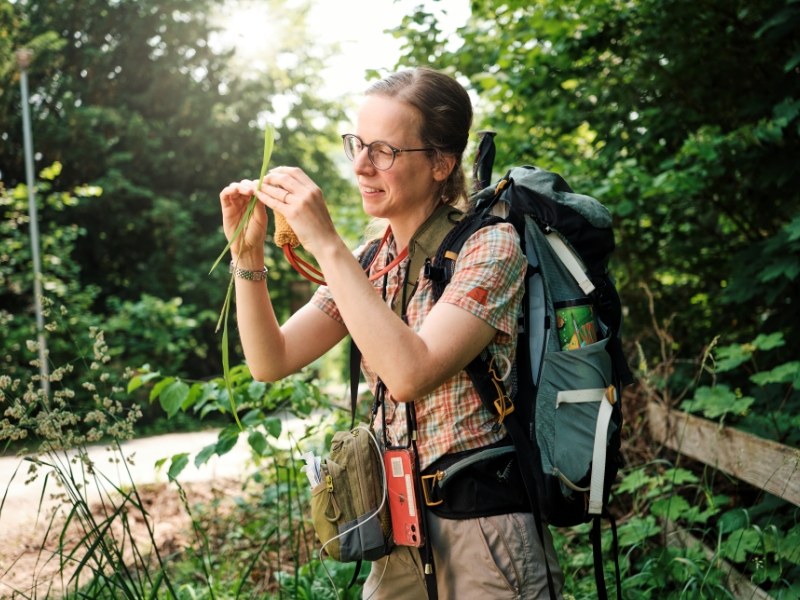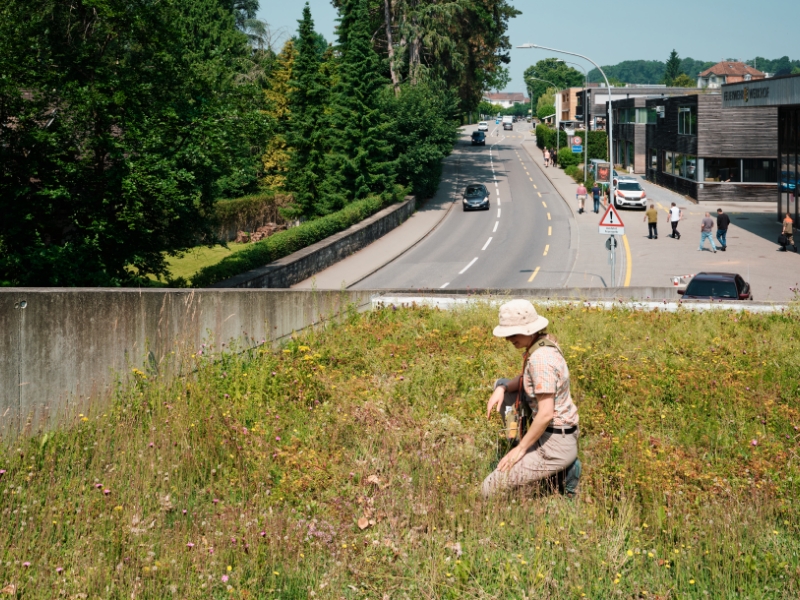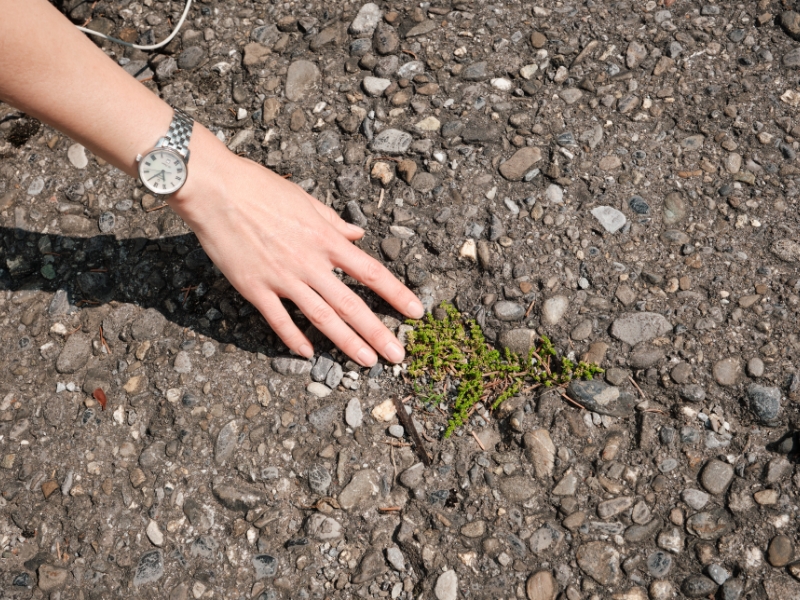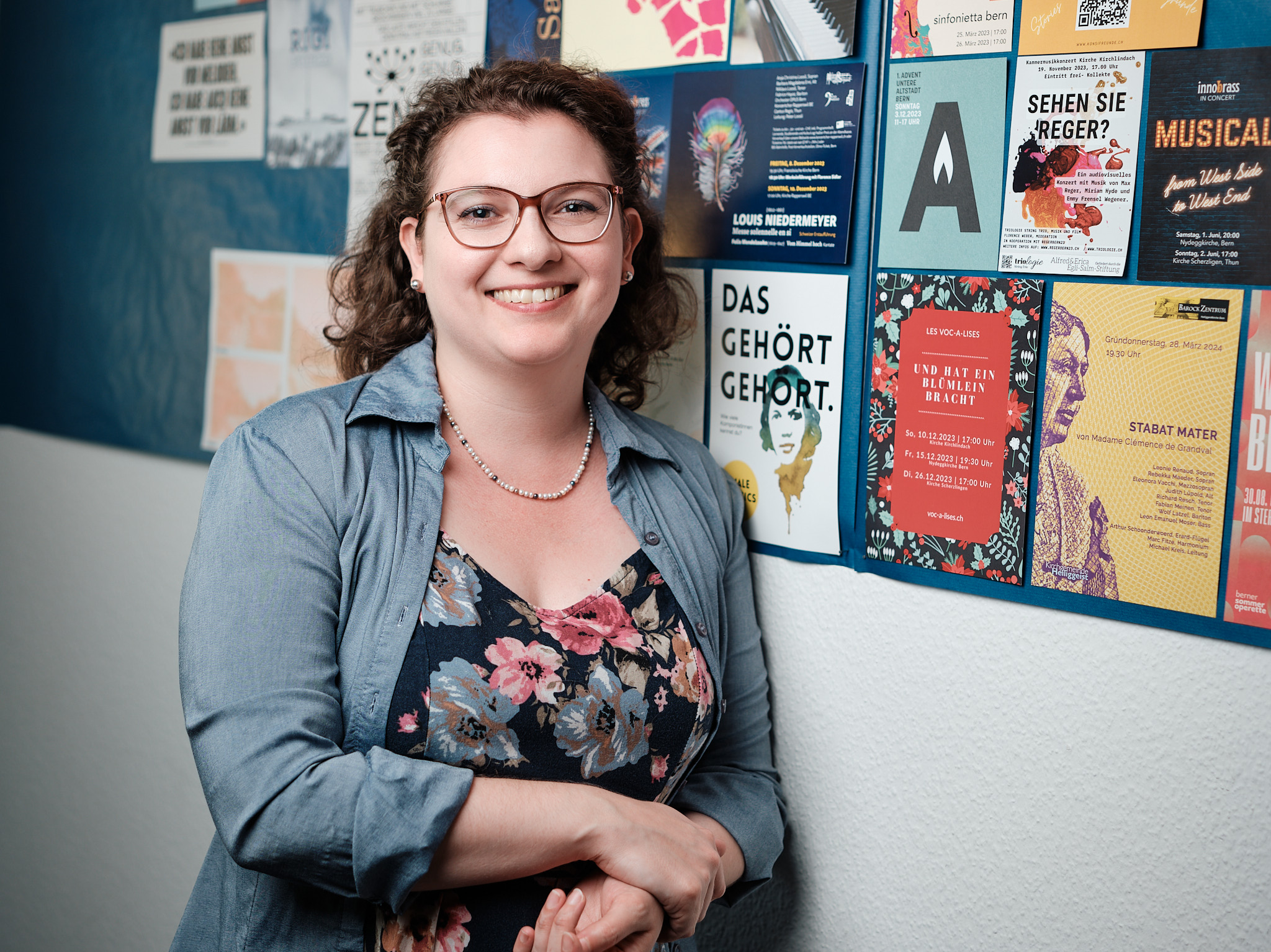Citizen science on wild plants
Out and about for Thun’s flora
Kathrin Häberlin is a passionate botanist. She voluntarily maps wild plant species for Florinventar – the Thun region's plant inventory project. Her precision here is just as helpful for this task as the task is for her personal well-being.

We meet at “Ländte Hünibach”. “I’ll be the person with a magnifying glass around my neck,” Kathrin Häberlin told me in her e-mail. In fact, I know straight away who she is among the people present, for no one else is as close to nature as she is. Shortly before we met, the botanist had discovered a rose near the lake shore; the first of its kind in “her” zone. “Roses are difficult to identify,” she stresses. She already knows that she will take a closer look at this plant after our walk through Hünibach.
Magazine uniFOKUS

A part of Bern
This article first appeared in uniFOKUS, the University of Bern print magazine. Four times a year, uniFOKUS focuses on one specialist area from different points of view. Current focus topic: A part of Bern.
Research on the lakeside promenade
During the growing season, Häberlin volunteers around one day a week as a botanist for the Thun region’s plant inventory project (see info box). The area to be mapped is five square kilometers in size and extends around Lake Thun. Her task is to record all native wild plant species found here within three years. The list of all the species she has already found is long, but she is still discovering new ones. If she finds something, she enters the botanical plant name on InfoFlora’s FlorApp and uploads the photos she has taken. This app is linked to the InfoFlora database which means her report is noted as a point on the map in the digital field book after a while.

The 37-year-old leads us to a tree near the lakeside promenade. “There is a lot to discover in the settlement area, especially on ruderal soil that is exposed to trampling, construction activities or other human activities,” she explains. The tree recently planted here is of foreign origin, and the soil around the tree is still exposed. These two factors lead to the settling of adventitious species and make the site dynamic for plant species that are reclaiming the open space. Using her magnifying glass, Häberlin recognizes a non-native lesser swinecress, Latin: Coronopus didymus. “The scientific botanical language is Latin. You can use it to communicate with other professionals all over the world.” As a qualified mathematician, she loves universal languages anyway.
Discovering botany – and herself
In addition to mathematics, Häberlin also studied physics at the University of Bern. Her decision to do so was motivated by feminism. “I wanted to study subjects that were not typically associated with my gender.” Although she performed outstandingly in these disciplines, during her studies she always felt as if she was a foreign body. “Just because you can do something doesn’t mean you have to enjoy it.” She fought her way through to her degree, specializing in climate physics. As a high school teacher of maths and physics, she was popular precisely because she helped young people find their way. The questions “Who am I?” and “What sets me apart?” are key. And eventually, it was precisely these questions that caught up with her.
“Every plant is different, just like people: We are of the same species and yet so different.”
Kathrin Häberlin
A message on her phone draws attention to the feedback from the app. “You’ve found a new species, well done.” This kind of message is also possible: “Are you sure?” This occurs whenever an entry based on the previous database entries collected by InfoFlora is not clear-cut and therefore needs to be checked more closely. “I am a perfectionist and self-critical. This makes it all the more important for me to be able to spend time outdoors and ground myself.” Because there is only 0 or 1 in the digital world, it’s good for her to become aware of shades of gray in nature. “Every plant is different, just like people: We are of the same species and yet so different.”
Subscribe to the uniAKTUELL newsletter

Discover stories about the research at the University of Bern and the people behind it.

“We have something beautiful here,” she interrupts, and has already discovered something that others would overlook. In a hole in the asphalt, a plant has managed to take root in a small amount of humus in the middle of a parking lot. Häberlin uses the magnifying glass to examine factors such as whether the hairs are single or multicellular and determines whether the stem has a greasy sheen. She concludes that it is a smooth rupturewort (Herniaria glabra). She strokes it gently and notes: “Here they have the courage not to go crazy with the pressure washer. This growing here is doing nobody any harm.” The whole thing is a really good illustration of the resilience of plants and shows that they can cope even in improbable locations.
The Florinventar project of the Thun region
The Florinventar project of the Thun region, supported by Pro Natura Bern, aims to map all wild plant species throughout the territory of the administrative district of Thun through voluntary work within ten years. The InfoFlora Foundation, which has signed a cooperation agreement with the University of Bern and whose German-speaking Swiss office is located in the Botanical Garden of the University of Bern, assesses the threats to all wild plants on this basis and renews the “Red Lists” every ten years. Only in the case of species that are difficult to identify does InfoFlora consider providing financial support so that the Florinventar project can send an expert with decades of expertise.
From hobby to profession
Sensitivity to the relevance of biodiversity is increasing, she confirms. It often happens that laypeople are interested in her work. As if it were staged, an attentive passer-by approaches us at this very moment and wants to know why we are heading toward these plants with such purpose. Häberlin introduces herself and the project. “And how do you know all the plant names?” The specialist tells the passer-by that her grandmother got her interested in flora from an early age and gave her identification books. However, she didn’t really start with meticulous species identification until 2021. “I love going out of the front door and doing science. And if you’re nerdy like me, you can make rapid progress in your knowledge of species with the support of other cracks.” The expertise she has gained from the Florinventar project has allowed her to change careers. Last summer, she was hired by “B + S Ingenieure und Planner” in the environmental department as a specialist in botany.
Kathrin Häberlin once wanted to understand what goes on on Earth by means of physics, but botany brings her closer to her goal. Through the plants, she not only comes into contact with humans, but also with animals. Because she moves predictably and often stays in one place for several minutes, she even managed to find herself in the middle of a grass snake mating ritual once. Even when hiking, she feels like an intruder in nature. “The only way I feel really integrated into nature is when botanizing.”
ABOUT THE INSTITUTE FOR LEGAL ITALIAN LANGUAGE AT THE UNIVERSITY OF BERN
The Istituto di italiano giuridico at the University of Bern (Institute for Italian Legal Language) is the first university center dedicated to the enhancement and promotion of and research into Italian legal language. As Italian is one of the official languages of Switzerland, standard legal texts such as laws and ordinances, procedural texts such as judgments, and administrative texts such as decrees are also written in Italian. Interpretive texts such as monographs, com-mentaries, and scientific articles are also formulated in Italian. The new institute of the Univer-sity of Bern was founded in the city that houses the Federal Assembly of the Swiss Confedera-tion and the Federal Council, and therefore maintains direct relations and close collabora-tions with the Federal Chancellery, Legislation and Language Section, and the State Council of the Canton of Ticino
